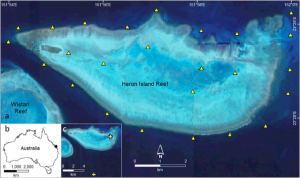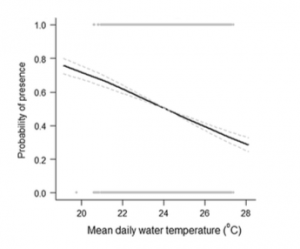The effect of environmental factors on fish movements
By William Evans, RJD Intern
Assessing environmental correlates of fish movements on a coral reef by Currey, et al. discusses the movement of fish dependent on environmental conditions. In this study, the researchers aimed to determine if environmental factors changed the location of Lethrinus miniatus, also known as the redspotted sunfish, on the reef to then make assumptions about the movement of that species as environmental factors change over time. There has been research done to show how fish react to changes in environmental stimuli but in relation to the environmental stimuli causing biological and behavioral alterations. In certain species, these alterations can be decreases in reproductive performance and slower growth rates.
The researchers sampled at Heron Island Reef in the southern portion of the Great Barrier Reef. The fish were captured, using a rod and reel on the reef slope by using a bait of pilchard and squid as bait. They were captured using barbless 8/0 and quickly vented and anaesthetized with Aqui-S. Once captured, a V13P transmitter with pressure sensor capabilities was surgically implanted in the abdominal cavity of each fish between the pectoral and ventral fins on the left side. The fish were recovered in fresh sea water and then released at the same capture site. The capture, venting and tagging process occurred in 8 minutes or less.
Each transmitter produced a different identification code of the same frequency to then relay data to the depth of that specific fish, with a maximum of 50 meters deep. To receive the data, 25 VR2 W acoustic receivers were deployed on the reef slope. Nineteen of the receivers were deployed on the reef slope and the other six were deployed in the lagoon. This arrangement of receivers was designed for a full year, of data collection and could detect acoustic transmitters within 270 m and 25 m deep. A total of sixty fish were tagged over three trips of twenty fish each: April 2011, February 2012, and September 2012.
The Facility for Automated Intelligent Monitoring of Marine Species sensor network and Great Barrier Reef Ocean Observing System mooring collected environmental data from April 2011 to September 2013 by on site monitoring. This environmental data included water temperature, atmospheric pressure, wind speed and direction, rainfall, and moon phase. The means of this data were averaged daily and weekly because of the vast amount of data collected over an extended period of time. These specific parameters were chosen because they were hypothesized to be the potential causes of reef movement among L. miniatus. Included in the biological parameters that were assessed, fork length (FL) was used to also determine if there was an effect based on fish size.Atmospheric pressure and wind direction data were not included in the final analysis because atmospheric pressure was correlated with water temperature and the data for wind was determined to be unbalanced because of the direction that the wind came.
Fish were used in the final analysis when they were detected for more than 5 days and when a receiver recorded the same fish presence more than once in the same day. From the 60 L. miniatus originally tagged, only 26 were able to be used for the final data analysis. These fish ranged in fork length from 372 mm to 493 mm and we detected from 2 to 52 weeks throughout the study by the receivers. The data was processed using sixteen sub-models to analyze the environmental effects of reef presences of L. miniatus. One of the models predicted that there would be less than a 50% presence of them on the reef slope if the daily mean water temperature was greater than 24°C. All of the other parameters that were measured were not considered to be important for this specific study. From using this temperature data and tracking the fish for up to 12 months, the researchers could make some predictions about temperature change and the effect it could have on fish on the reef, specifically L. miniatus. The data displayed that as water temperature increased, the presence of L. miniatus on the reef decreased.
Most of the studies concerning the effects of temperature on fish are about the biological changes in the fish such as changes in metabolism and sexual behaviors. This study can help predict the distribution of L. miniatus as temperatures increase or change their location in the water column in order to be at their preferred temperatures. Additionally, because increasing temperature was the main factor in determining the presence of L. miniatus on the reef, the researchers can infer that as temperature increases, the presence of the species will reduce on the reef slope. Although this study was only based around one species, this research can benefit managers in helping them understand how climate change will effect the movement of reef fishes and how the fishery will be impacted over time.
References:
Currey, Leanne M., Heupel, Michelle R., Simpfendorfer, Colin A., Williams, Ashley, J. (2015). Assessing environmental correlates of fish movement on a coral reef. Coral Reefs.
Donelson JM, Munday PL, McCormick MI, Pankhurst NW, Pankhurst PM. (2010). Effects of elevated water temperature and food availability on the reproductive performance of a coral reef fish. Mar Ecol Prog Ser 401:233–243.
Munday P, Kingsford M, O’Callaghan M, Donelson J. (2008a). Elevated temperature restricts growth potential of the coral reef fish Acanthochromis polyacanthus. Coral Reefs 27:927–931.


